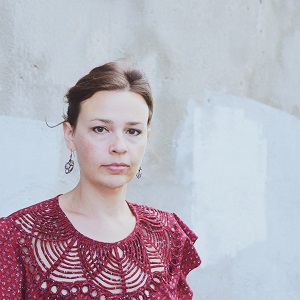
A Window into “Later”
Contributor’s Marginalia: Danika Stegeman LeMay responding to Susan Hutton’s “Later”
I often begin a poem by giving it a landscape. A poem needs a place for language to live, folds for images to haunt, hollows for a reader to inhabit. It’s a way in.

In her poem “Later,” Susan Hutton carefully constructs, sentence by sentence, a vivid landscape that bears more than what’s immediately evident on its surface. We encounter a landscape that turns a precarious now into an irrevocable future. The poem lives on the precipice of later, of a potentially uninhabitable future earth we are close enough to see.

It began with blackberries
and goats to keep the brambles
down.
The poem invites us into blackberries and brambles. Precious vessels of sustenance and light, sweetness guarded by something dangerous. Thorns meant to protect but also to obscure, to keep out, or, failing that, to entangle. Welcome, but step carefully.

An occasional coyote,
impossible to catch, captivated
the life of the mind.
Next arrive the coyotes. Scavengers, cunning and wild, made captive by the human mind. A coyote can live anywhere, on the fringes of an urban wasteland. I’ve seen them near the railroad tracks at the edge of the city or drinking from the banks of our polluted river. A coyote means survival at any cost. It is hope; it is a last hope.

For a while
the land was covered with litter
and poisons you couldn’t see
but the earth was still really beautiful
from orbit.
Then “Later” admits the poisons we know so well but don’t see. Toxic waste buried between downtown and the west bank of the river. Water unfiltered from the tap. The societal systems, decaying long and deadly as uranium, housed in our synapses. But the earth is still beautiful from far away, from the outside. It’s about vantage. It’s about perspective. I used to think that my city took care of its people until I realized it takes care of its white people.

Astronauts saw a glacier
in South America that was actually a desert
of salt and flat enough to calibrate
distance from the earth’s surface
to tiny spots in space.
And now we come to it, the glacier—ice, hope for life, for renewal—transformed to a desert of salt, near impassable. This is the turn. The salt desert’s blankness marks a reference point to calibrate where we are, where we were, where we go from here. I took these photographs of my post office—now blank and razed—a reference point.

Turned that way,
miles don’t mean the same thing,
but someone launched a satellite
that breached the imagination.
See the place where you find yourself, “Later” seems to ask. Turn it in your hands and look from all possible dimensions, including time. Orbit it like a satellite and layer the images over themselves, points across multiple planes. Feel the breach, the rupture, the break. Understand what caused this building to burn.

Llama trains
carried the salt across the Incan empire,
a difficult distance because nothing
ever rises. Not even the horizon.
These final lines, spoken in the present, point backward and forward simultaneously. Like Hutton’s poem, our moment contains both past and future, and our landscape is turning. A horizon is a line with limits. What weight do we carry, and how do we traverse the difficult distances from here?

